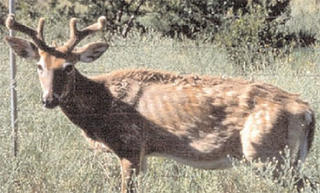Chronic Wasting Disease: Is it Here? What are the Human Risks?

The deer you see in the picture is a deer affected by chronic wasting disease (CWD). We consider it important that you know that there could be a possible risk to humans by consuming meat from infected animals.
The first question is it in Virginia? A deer with the disease has been found within ten miles of the Virginia boarder. Would that mean that deer with this disease are in Virginia we would conclude yes. Deer range sometimes at considerable distances, and we doubt they would stop at the boarder and just turn back.
The Virginia Department of Game and Inland Fisheries have stated on their website that CWD deer have as yet not been found in Virginia, but they are telling you to take precautions. You should not eat meat from infected deer, and you should take new precautions in field dressing deer and processing the meat. They have made that very clear on their web page. But they have not rang the alarm bells that these deer are likely in Virginia, but if you look at this memo you will see that there are reasons for concern.
For a moment I would like to explain to you some things about the chronic wasting disease. The big thing is that knowledge about this disease is slim to none. The CDC suspects that there is a "species barrier," which means that the disease is not likely to be transmitted to another species, like us humans. In lab tests, however this may have been proven to be a false conclusion:
" Although CWD does not appear to occur naturally outside the cervid family, it has been transmitted experimentally by intracerebral injection to a number of animals, including laboratory mice, ferrets, mink, squirrel monkeys, and goats.[1,26] In an experimental study, the CWD agent was transmitted to 3 of 13 intracerebrally injected cattle after an incubation period of 22 to 27 months.[27] " (a study from a CDC scientist)
Things to note about this finding is that the "species barrier" was broken. That the incubation period is long, and the CDC is the first to admit that it does not know how it is transmitted even between deer.
Is there a risk to humans? Without getting overly technical I can say with some confidence yes, although that risk maybe low. There are reported cases of humans developing a prion disease with a history of eating infected game animals. The disease is particularly severe and always fatal, and the symptoms are horrendous, if you were unfortunate enough to contract it.
These are the precautions that the Virginia Game Commission is now also recommending:
"Hunters should avoid eating meat from deer and elk that look sick or test positive for CWD. They should wear gloves when field-dressing carcasses, bone-out the meat from the animal, and minimize handling of brain and spinal cord tissues. As a precaution, hunters should avoid eating deer and elk tissues known to harbor the CWD agent (e.g., brain, spinal cord, eyes, spleen, tonsils, lymph nodes) from areas where CWD has been identified."
You should not take these precautions lightly. Personally, since I do not have to, I will not be eating venison.
photo credit: Virginia Department of Game and Fisheries


2 Comments:
Thanks for the comment.
So far the Virginia Department of game has taken a low profile on this, and it hasn't been picked up by the local media.
On their web page they make no mention of it being found within ten miles of Virginia, but that info is tucked away in the news release that I called a memo.
This disease first started in the Midwest. The CDC and others have been quietly doing research on if this can affect humans. What is publicly out there is that there was only three cases that also had a link to people eating venison. However, when I did go through the research, there are actually more cases, this did not make it to the public pages of the CDC.
With the similarities to Mad Cow disease, I think they are taking a very cautious approach to informing the public.
In college I spent several years studying diseases and viruses. Other prion diseases have broken the "species barrier" and in the CDC lab tests CWD was transferred to other lab animals. Most telling was the monkey that has genetic similarities to humans.
This is a disease to watch. The long incubation period for the disease makes it hard to establish a connection between the human form of the disease and the animal form. Nevertheless, I personally would not want to take the chance.
Thanks Mom,
I am glad that they are publishing up in Winchester. My concerns are with the lengthy incubation period of the disease even healthy looking deer may be infected. I don't expect the Viriginia game commission will be emphasising this enough. In the midwest they have also taken a low profile on the saftety of eating venison.
The CDC has taken the position that the "species barrier" is intact. Although, I have seen from their study that may not be the case.
Post a Comment
<< Home